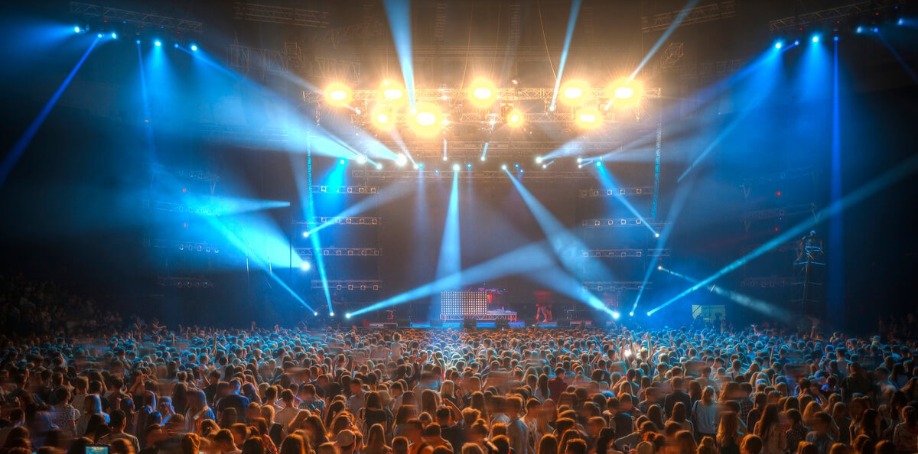
You've decided to add pizazz to your event with projection mapping. Should you stick with a 2D format? Or should you settle for nothing less than 3D? These seem like simple questions to answer. In reality, making a smart choice between 2D and 3D Projection Mapping takes a little time and sensitivity.
Here's what to consider as you weigh your options.
What's the Difference Between 2D and 3D Projection Mapping?
To make an informed decision, you'll need to know more about the technologies you're considering. They work on the same premise, as a camera controls the images every time, but their applications can be quite different.
"2D refers to projection on flat surfaces such as screens and walls; 3D refers to projecting onto three-dimensional objects. 3D is capable of creating mind-bending effects through warping content with a controlled software, as images take on physical form," says Daniel Lourenco, national head of production at Encore Event Technologies.
It's tempting to assume that attendees both want and need the most technologically superior product you can offer. That isn't always true.
"With so many new tools entering the market, event professionals need to implement practices for choosing the right mix of technology that will ultimately bring a good ROI, not just jumping on the latest tech bandwagon just for the sake of it," advises Toby Heelis, CEO of Eventopedia.
To determine if 3D projection mapping is a good match for your event, think carefully about the conference, beginning with the venue itself.
Know Your Venue: What Space is Available?
You've spent months choosing the right event venue—with good reason. "Your venue can make or break the event," writes Thomas Smale, founder of online business merger and acquisition advisory firm FE International. Your space can also dictate what projection mapping solution makes sense.
In theory, 3D projection mapping≈ could be used almost anywhere. Even small spaces—or objects—can benefit.
"Projection mapping uses technology to project objects onto a surface. Using this kind of special technology, everyday objects are transformed into a display surface for video projection. These objects could be as complex as an entire landscape, or as simple as just a few shapes that help to enhance the ambiance of a room," writes Mark Battalini at television lighting and consulting firm, Frank Gatto and Associates.
But the success of 3D projection mapping often depends on architectural elements. If you're planning to hold an event in a flat, square space with no columns or windows to wrap around and play with, the effect could be blunted.
Fortunately, you usually have plenty of event space choices. In Orlando alone, for example, there are more than 450 hotel and resort options, says the American Express team. That's one reason why this city is such a hotspot for events.
It pays to walk through your space, either in person or virtually, to determine if 3D projection mapping is even an option. If not, your decision is a simple one.

Cost Considerations: How Much Can You Spend?
You've determined that your space can support 3D projection mapping elements. Can your budget do the same?
In general, projection mapping can save you money over traditional marketing displays. "Instead of buying décor, banners, and props to complete your event's theme, you can project decorations on the walls, floors, or other objects at your event," writes Kaitlyn Tatulli at event and meeting management company Aventri.
But there is a difference in cost between 2D and 3D projects. According to an Event Manager Blog survey, 82 percent of corporate event planners cite budget as their biggest concern. You may not have the flexibility to build the display of your dreams.
"The average projection mapping service costs about $10,000 per one-minute of 3D video content. But in addition to the cost of the video development time, you'll also need to take into consideration the cost of the projectors, media server, and hard drive," explains the team at audio visual company On Services.
By sticking with traditional 2D projection mapping, you could still deliver an amazing experience without the large price tag.
Deadline Deal-Breakers: How Much Time Do You Have?
Every event comes with a custom schedule, and some are more lenient than others. Your lead time (or lack of it) could also help you understand if a 2D or a 3D option is best for you.
"We found that event planners plan an average of five to nine events per year. These events can take anywhere from two days to an entire month to plan depending on the size," writes Melissa Del Monte, lead generation specialist at social lead generation tool CoPilot AI.
If the next project on your list is tiny and coming up fast, you may not have enough time to pull off the complexities associated with a 3D projection mapping project.
How much time do you need? Kristen Radford at Endless Events suggests that small projection mapping projects should be in the planning stages at least six weeks before it begins. The more complex the project, the longer you'll need to pull it off in style.

Assess the Impact: Why Are You Adding Projection Mapping?
Industry experts have big plans for projection mapping, and can encourage you to take the leap into the 3D world.
“Tools originally developed for big-budget film special effects are now being used by small design teams on motion design projects. Where projects have been previously realized in 2D, things will move into 3D with interactivity becoming more and more prevalent,” says Carl Timms, head of film and video at DRPG.
In some cases, being on the cutting edge of technology makes a lot of sense. If you're in a competitive market, for example, a presentation with 3D elements could help you stand out.
Tom Ring, senior project manager at technical event production Hawthorn, spoke with AV Magazine about an event designed for audio visual professionals. “Presenting a huge production to some of the industry's leading professionals isn't easy. Events such as this also involve a range of suppliers, as different manufacturers want to demonstrate what their equipment is capable of, which leads to further challenges," he said.
An audience like this might grow bored with 2D projections and demand the best that tech has to offer. Deliver that, and you could benefit.
"What kind of potential value can projection mapping bring? It is primarily entertainment value—sales, clients, attendees, experience something that is beyond anything they have experienced before. It is an intangible value that creates excitement and will keep your attendees engaged and looking for more," explains the CLE Productions team.
3D projection mapping can include elements of customization and virtual reality. That could help you stand out, especially if attendees feel like the experience is somehow personal. “Personalize your event with custom touches that attendees haven't experienced at other events,” recommends Ari Jones, owner of ARJ Productions, an event planning company based in Washington, D.C.
Using 3D projection mapping can allow you to reach a high level of personalization. Colors could shift as people walk into the room. Their touch could make the scene change. You could make the show interactive and change it according to attendee requests. Do all of that, and you provide an experience attendees will never forget.
But it's important to remember why your attendees come to events like yours. Some of their goals have nothing to do with fancy technology and unique experiences.
Global life science events consultancy Curtis and Coulter suggests that conference attendees hope to network, expand their knowledge, present ideas, meet peers and learn. Someone like this might appreciate an interesting show. But if they don't meet these other goals, they may still walk away from your event feeling dissatisfied. The technology you use can enhance the attendee experience so the conference is memorable. But don't get so attached to choosing technology that you forget to support key objectives.
Measure and Learn: What Worked Well?
Once it's over, and you've received responses to the post-event survey, you can hold an event debrief. It's during this process that you can examine whether the venue itself and use of technology wowed attendees or left them feeling flat.
Don't be afraid to ask about the venue. "Event managers often don't ask questions about the facilities, but rooms that are too hot or too cold, or have uncomfortable chairs will affect the attendee's value received," says survey consultant Fred Van Bennekom, D.B.A.
Make sure your survey questions are also about the technology used in the event. The answers could help you determine how you'll approach upcoming events.
Images by: rawpixel/©123RF.com, rawpixel/©123RF.com,lindrik/©123RF.com


